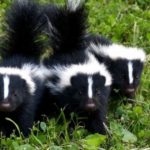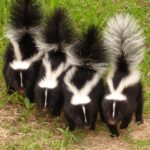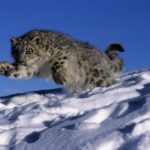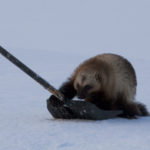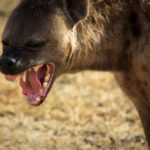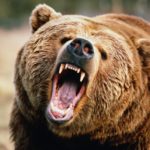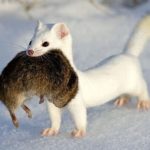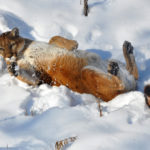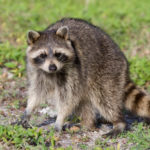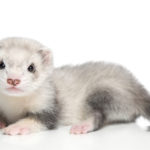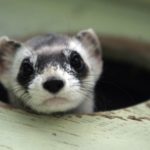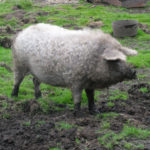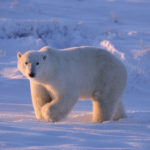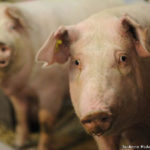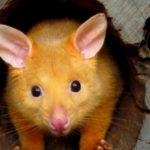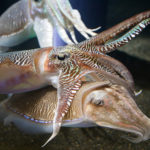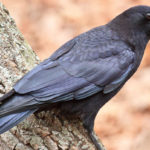Skunks
 The word skunk has become almost a household name, these animals are very famous for their unpleasant smell. But how much do we know about their life in nature? According to the estimates of different zoologists in the world, there are 9-10 species of skunks, all of them are united in the family of the same order of the Predatory. Their close relatives are badgers, ferrets, martens.
The word skunk has become almost a household name, these animals are very famous for their unpleasant smell. But how much do we know about their life in nature? According to the estimates of different zoologists in the world, there are 9-10 species of skunks, all of them are united in the family of the same order of the Predatory. Their close relatives are badgers, ferrets, martens.
The weight of the largest pig skunks reaches 9 kg, and the smallest spotted skunks weigh no more than 0.5-1 kg. The muzzle of these predators is slightly elongated with a wide flat back of the nose, adapted for digging the earth. The body is covered with thick, hard fur, especially the long hair on the tail, when it swells, form a magnificent whisk. Coloring in all types of skunks is the same: the hair on the body, as well as the nose and skin on the legs are black, on the top of the head there is a large white spot that gradually turns into 1-2 strips stretching along the back to the tail. In spotted skunks, several intermittent bands form a whimsical mottled pattern.
The habitat of all family members extends to both American continents. In the north, it reaches the borders of Canada, covers almost all the wooded areas of the USA, in the south includes Mexico, Guatemala, Nicaragua, Costa Rica, Belize, El Salvador, Bolivia, Argentina, Peru, Chile and Paraguay. The favorite habitats of these animals are deciduous forests, shrub thickets, fringes along river banks, rocky slopes. Usually skunks hide in burrows, which they themselves dig, often take up abandoned dens of foxes, tree hollows, hollows in stumps. Although skunks prefer to search for food alone, several individuals can live together in one hole (the maximum known number is 7). Nevertheless, females with offspring always occupy individual dwellings, which are not tolerated by neighbors.
At this time, animals prefer to sit out in burrows and almost nothing to eat, surviving due to stores of subcutaneous fat. On the hunt, they prefer to go out in the dark, but occasionally they can be seen in the daytime. Skunks are omnivorous, so their diet includes a wide range of gifts of nature: roots and leaves of plants, berries, nuts, mushrooms, insects, larvae, earthworms, frogs, toads, salamanders, moles, bird eggs, small rodents, lizards and snakes.
They extract their prey from the ground and forest litter, using strong paws and a nose. Specific search for food can explain the perfectly developed sense of smell and at the same time the strong short-sightedness of skunks. Sometimes animals eat carrion, they are often noticed on the outskirts of cities, rummaging in garbage containers. By the way, skunks are also not worse than bears. Thick and hard fur reliably protects them from stings of bees, and clawed paws allow you to easily destroy the hive. But the “robber” talent is not an inborn, but an acquired skill. The female, destroying the hives, is more likely to teach this and her cubs.
Skulls begin to breed in March. These are polygamous animals, so one male can mate with several females. Participation in the future fate of the offspring, he does not accept. Pregnancy lasts 63-66 days, in May the female gives birth to 3 to 10 cubs. Kids appear in the light of the blind, deaf, naked. Their skin resembles a soft velor, but already has a characteristic color for adults. After 3 weeks they begin to see, and after 2 months they start to feed themselves. Nevertheless, young animals remain with the mother for a relatively long time, until reaching puberty, which comes in 1 year.
The maximum life expectancy recorded in these animals in captivity was 10 years. However, in nature, most individuals survive only up to 1-3 years. The main cause of death of skunks – various diseases, including rabies, as well as freeways, where sluggish, blind animals fall under the wheels of cars. In addition, they are attacked by foxes, bears, coyotes, cougars, lynxes, badgers, owls and buzzards. To protect the skunk uses its famous weapon – the smell.
Under the tail of the animals are paired anal glands, in which a fetid liquid containing sulfur compounds of ethyl and butyl mercaptans accumulates. When a threat of skunk muscle contraction throws a jet of secretion in the direction of the enemy. The stench of this substance is incomparable, it can not be tolerated either by animals or by humans. It is interesting that all Latin generic names of skunks are somehow translated as “stinking”, “stinking”, etc.

